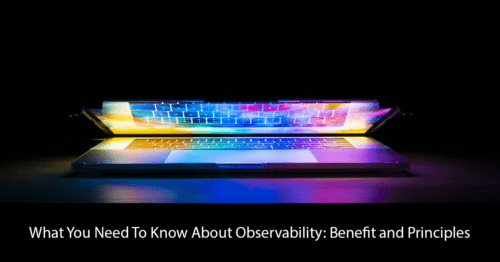Observability is not a factor to ignore due to the ever-increasing technologies and services modern enterprise solutions require. To name a few – cloud, DevOps, microservices, containers, serverless, etc. The benefits of utilizing observability tools are clear as this increases velocity and reduces the time to know about issues that could arise at any point from staging to production. Observability is a reliable way to master complexity, with a holistic insight into changes taking place within your company’s software and systems.
Getting to know the actual state of something by a mere examination of external factors to determine the root cause of issues, including what can be done to improve it at the root level, is essential to maintaining and enhancing infrastructure. Observability does this to help provide insights into the whole infrastructure.
Thus we could say; Observability entails assembling log fragments, monitoring tools, organizing them to derive actionable knowledge of the whole environment. This way, you can get proper insight.
In another definition, Observability can be said to be “the ability to answer any question about your business or application, at any time, notwithstanding the complexity of your infrastructure. How you do this in the application development, and operations context is simple —instrumenting systems and applications to collect metrics, traces, and logs and sending all of this data to a system that can store and analyze it and help you gain insights.
The Benefits of Observability
Following the increased complexity of modern infrastructure and the undisputed need for better monitoring everywhere in the stack, the need for monitoring cannot be overemphasized. Some of the benefits include;
- A complete grasp of complex systems
- More innovative planning for code releases and application capacity
- Remarkably fast problem resolving solutions with a shorter MTTR
- Clear and insightful incident reviews
- Reliable uptime and excellent performance
- Results in customers happiness and high revenue returns
Interestingly, observability has core principles, and we’d examine them as it can aid us to determine how it is applicable in the real world.
Basic Principles Of Observability
Some of the principles of Observability include:
Curation vs. Participation
Curation is important in a modern observability platform as it tends to give teams an edge in productivity and efficiency. It cuts complexity down to size, selects, and presents relevant insights to users. In addition, it is also crucial for such platforms to support participation. This entails having inclusive custom metrics and data sources for users to work with.
On the other end, participation is flexible. In other words, it makes it easy to capture and manipulate data in distinctive ways. Even when the platform cannot correctly present that data. It relies on programmability and also gives users the needed tools to help themselves. API’s are some of those tools.
Full Transparency
A good observability platform requires a comprehensive and high-level view of application performance. Another capability is its ability to drill down into minute details with no surprises and full context. It is equally noted for providing a consistent, intuitive, and transparent path for moving between high-level and lower-level views.
Easy To Start
Platform developers should strive to make their out-of-box experience as intuitive as possible. Above all, most users first experience the platform while using it to resolve an incident.
“Fast” Is A Feature
For a modern observability platform, getting the right information to where it is needed is very important. This singular action can make or break a company’s reputation. However, moving fast doesn’t stop just at being fast. Most importantly, it goes beyond going fast; it’s also about precision and reliability, including responsiveness.
Applications Rule
What many users are interested in is “whether their application is healthy or not.” Customers are more interested in determining the specific source of issues as quickly and accurately as possible when their applications experience problems. What can be deduced from here is that an observability platform functions at its peak when it focuses on measuring application performance and on surfacing application-performance roadblocks
Support Power User
Power users often access, appreciate, and explore the deeper capabilities that distinguish a product from its competitors. As a result, this makes this power users product’s most respected and influential champions.
Talking about application monitoring and observability, many users are often faced with very tough and demanding jobs. Many of these users even live in their integrated development environments (IDEs). They attempt to automate everything to make things easy, and they stand to benefit the most from a programmable and extensible observability platform.
Putting It All Together
To conclude, a modern observability platform is expected to provide enough information to anyone on call. According to Baron Schwartz, “Observability is not the microscope. It’s the clarity of the slide under the microscope.” Observability helps you focus on what matters and in addition, you deduce actionable insights which aid users in pinpointing where issues may arise from. It tells you the health of your environment.
Learn how FusionReactor can help with your observability needs and in addition, check out our self-managed solution for IT operations.










